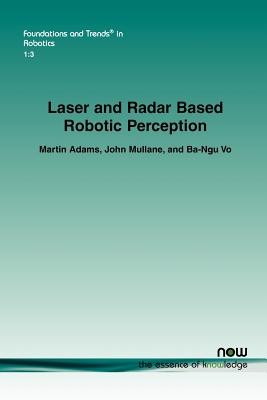
- We will send in 10–14 business days.
- Author: Martin Adams
- Publisher: Now Publishers
- Year: 2011
- Pages: 130
- ISBN-10: 1601984723
- ISBN-13: 9781601984722
- Format: 15.6 x 23.4 x 0.7 cm, minkšti viršeliai
- Language: English
- SAVE -10% with code: EXTRA
Reviews
Description
A crucial component of perception is the understanding of information which has passed through a sensor's detection process. In the world of autonomous robotics this takes the form of sensor understanding and modelling, feature detection, predicting measurements/observations, feature matching and sensor data representation. Laser and Radar Based Robotic Perception presents a review of autonomous robotic perception, exploring recent work from the autonomous robotics and tracking communities in general as well as from the authors' own experiences. Throughout the text, experiments and results are derived from the authors' experiences with laser and radar based sensors. The concepts used in the experiments, and conclusions drawn from them, are then compared with state of the art perception methods in a review type fashion. Laser and Radar Based Robotic Perception also reviews and presents methods which cope probabilistically with missed detections (the possibility of a sensor not detecting an object of interest), object spatial uncertainty (in which detected objects are given uncertain range and/or bearing values due to sensor noise) and false alarms (the possibility of a sensor reporting a detection, due to noise, when in fact nothing (or nothing of interest) is present). Environment measurement models based on these phenomena are therefore analysed. A further concept, often over-looked in the robotic, but apparent in the tracking literature, is that of estimating the correct number of features in an environment. Recent work which advocates the joint estimation of map features with respect to their number as well as location is reviewed.
EXTRA 10 % discount with code: EXTRA
The promotion ends in 23d.04:09:57
The discount code is valid when purchasing from 10 €. Discounts do not stack.
- Author: Martin Adams
- Publisher: Now Publishers
- Year: 2011
- Pages: 130
- ISBN-10: 1601984723
- ISBN-13: 9781601984722
- Format: 15.6 x 23.4 x 0.7 cm, minkšti viršeliai
- Language: English English
A crucial component of perception is the understanding of information which has passed through a sensor's detection process. In the world of autonomous robotics this takes the form of sensor understanding and modelling, feature detection, predicting measurements/observations, feature matching and sensor data representation. Laser and Radar Based Robotic Perception presents a review of autonomous robotic perception, exploring recent work from the autonomous robotics and tracking communities in general as well as from the authors' own experiences. Throughout the text, experiments and results are derived from the authors' experiences with laser and radar based sensors. The concepts used in the experiments, and conclusions drawn from them, are then compared with state of the art perception methods in a review type fashion. Laser and Radar Based Robotic Perception also reviews and presents methods which cope probabilistically with missed detections (the possibility of a sensor not detecting an object of interest), object spatial uncertainty (in which detected objects are given uncertain range and/or bearing values due to sensor noise) and false alarms (the possibility of a sensor reporting a detection, due to noise, when in fact nothing (or nothing of interest) is present). Environment measurement models based on these phenomena are therefore analysed. A further concept, often over-looked in the robotic, but apparent in the tracking literature, is that of estimating the correct number of features in an environment. Recent work which advocates the joint estimation of map features with respect to their number as well as location is reviewed.


Reviews